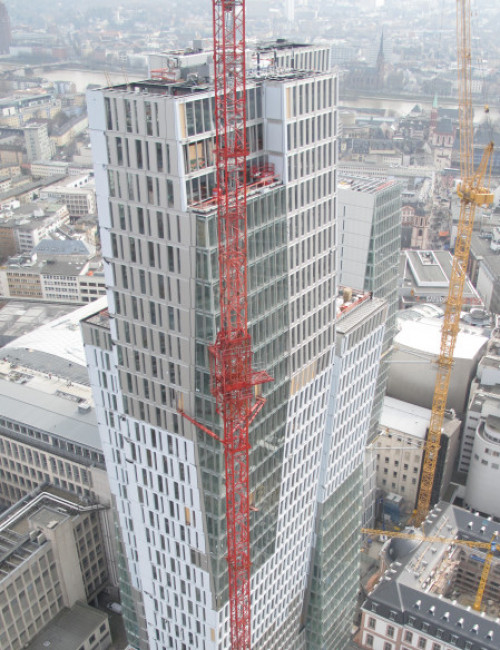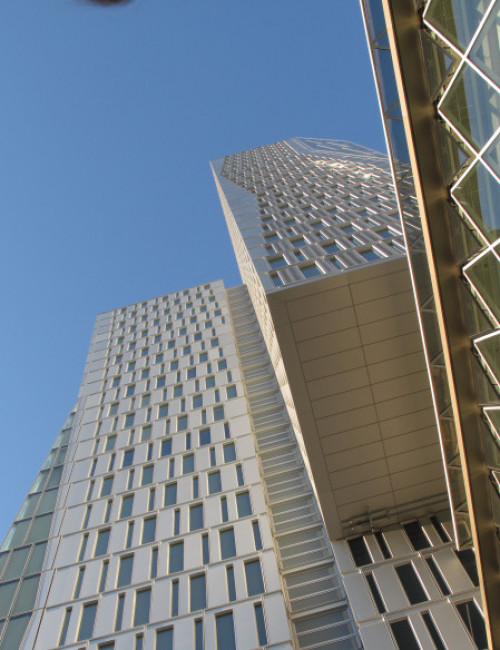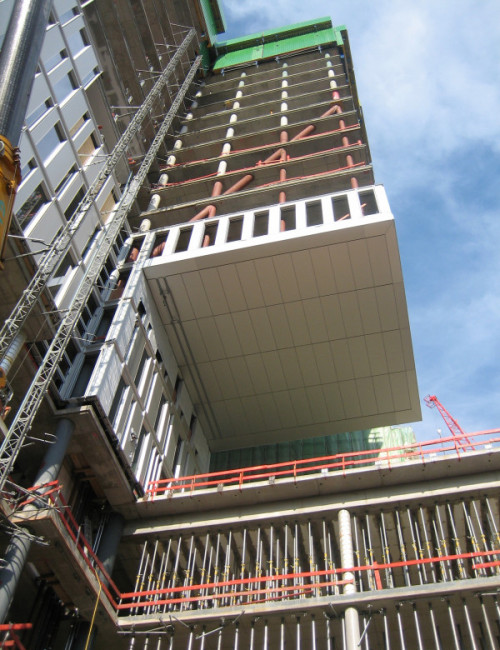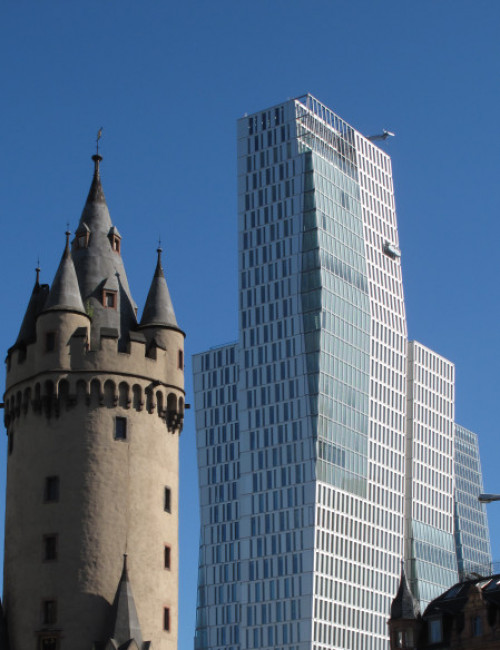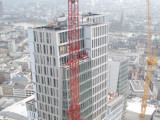Nextower
Frankfurt am Main
- Facts
-
Metrics
You must be a CTBUH Member to view this resource.
Official Name
Nextower
Other Names
Tower am Thurn & Taxis Palais, PalaisQuartier Office Tower
Name of Complex
Type
Building
Status
Completed
Completion
2009
Country
City
Address
Function
A mixed-use tall building contains two or more functions (or uses), where each of the functions occupy a significant proportion of the tower's total space. Support areas such as car parks and mechanical plant space do not constitute mixed-use functions. Functions are denoted on CTBUH "Tallest Building" lists in descending order, e.g., "hotel/office" indicates hotel function above office function.
Office
Structural Material
Both the main vertical/lateral structural elements and the floor spanning systems are constructed from steel. Note that a building of steel construction with a floor system of concrete planks or concrete slab on top of steel beams is still considered an “all-steel” structure as the concrete elements are not acting as the primary structure.
All-Concrete
Both the main vertical/lateral structural elements and the floor spanning systems are constructed from concrete which has been cast in place and utilizes steel reinforcement bars and/or steel reinforced concrete which has been precast as individual components and assembled together on-site.
All-Timber
Both the main vertical/lateral structural elements and the floor spanning systems are constructed from timber. An all-timber structure may include the use of localized non-timber connections between timber elements. Note that a building of timber construction with a floor system of concrete planks or concrete slab on top of timber beams is still considered an “all-timber” structure as the concrete elements are not acting as the primary structure.
Mixed-Structure
Utilizes distinct systems (e.g. all-steel, all-concrete, all-timber), one on top of the other. For example, a Steel Over Concrete indicates an all-steel structural system located on top of an all-concrete structural system, with the opposite true of Concrete Over Steel.
Composite
A combination of materials (e.g. steel, concrete, timber) are used together in the main structural elements. Examples include buildings which utilize: steel columns with a floor system of reinforced concrete beams; a steel frame system with a concrete core; concrete-encased steel columns; concrete-filled steel tubes; etc. Where known, the CTBUH database breaks out the materials used within a composite building’s primary structural elements.
All-Concrete
Height
136 m / 446 ft
Floors Above Ground
35
# of Elevators
9
Rankings
-
By function
You must be a CTBUH Member to view this resource.
-
By material
You must be a CTBUH Member to view this resource.
Construction Schedule
Construction Start
Completed
Structural Engineer
The Design Engineer is usually involved in the front end design, typically taking the leadership role in the Schematic Design and Design Development, and then a monitoring role through the CD and CA phases.
Other Consultant
Other Consultant refers to other organizations which provided significant consultation services for a building project (e.g. wind consultants, environmental consultants, fire and life safety consultants, etc).
Other Consultant refers to other organizations which provided significant consultation services for a building project (e.g. wind consultants, environmental consultants, fire and life safety consultants, etc).
Material Supplier
Material Supplier refers to organizations which supplied significant systems/materials for a building project (e.g. elevator suppliers, facade suppliers, etc).
Material Supplier refers to organizations which supplied significant systems/materials for a building project (e.g. elevator suppliers, facade suppliers, etc).
You must be a CTBUH Member to view this resource.
Developer
MAB; Meyer Bergmann
Architect
Usually involved in the front end design, with a "typical" condition being that of a leadership role through either Schematic Design or Design Development, and then a monitoring role through the CD and CA phases.
KSP Engel und Zimmerman Architekten
Structural Engineer
The Design Engineer is usually involved in the front end design, typically taking the leadership role in the Schematic Design and Design Development, and then a monitoring role through the CD and CA phases.
The Engineer of Record takes the balance of the engineering effort not executed by the “Design Engineer,” typically responsible for construction documents, conforming to local codes, etc.
KHP Konig und Heunisch Planungsgesellschaft
MEP Engineer
The Design Engineer is usually involved in the front end design, typically taking the leadership role in the Schematic Design and Design Development, and then a monitoring role through the CD and CA phases.
Peter Berchtold - Engineering Consultants
Contractor
The main contractor is the supervisory contractor of all construction work on a project, management of sub-contractors and vendors, etc. May be referred to as "Construction Manager," however, for consistency CTBUH uses the term "Main Contractor" exclusively.
BAM Deutschland AG
Other Consultant
Other Consultant refers to other organizations which provided significant consultation services for a building project (e.g. wind consultants, environmental consultants, fire and life safety consultants, etc).
Other Consultant refers to other organizations which provided significant consultation services for a building project (e.g. wind consultants, environmental consultants, fire and life safety consultants, etc).
Material Supplier
Material Supplier refers to organizations which supplied significant systems/materials for a building project (e.g. elevator suppliers, facade suppliers, etc).
Material Supplier refers to organizations which supplied significant systems/materials for a building project (e.g. elevator suppliers, facade suppliers, etc).
Anders Metallbau GmbH; HALFEN
CTBUH Awards & Distinctions
Best Tall Building, by Region, Europe 2010 Award of Excellence
2010 CTBUH Awards
About Nextower
Positioned outside the limits of the cluster of high-rises in the neighboring banking district, the PalaisQuartier forms the architectural highpoint of a new district in downtown Frankfurt—with shapes that catch the eye even from a great distance, its expressive shape creates an exciting counterpart. Together with the Thurn und Taxis Palais Townhouse (recently rebuilt to preserve its original façade), and the “MyZeil” shopping mall, the PalaisQuartier rounds out a new district which has a decidedly urban flair.
The urban planning concept from the outset envisaged the construction of an urban quarter on the former Post Office site that linked various facilities such as accommodation, hotels, offices, restaurants, event rooms and retail outlets with each other. The new combination of reconstructed space, inner-city shopping mall, office high-rise tower and hotel creates a lively urban place in the center of Frankfurt. The Thurn und Taxis Plaza forms the publicly accessible center of the new quarter, enriching the inner city.
Two materials, namely aluminum and glass, define the appearance of the face of the building, which is designed as segmented curtain façades. The eye-catching characteristic of the tower is, when seen from the side, the diamond-shaped fully glazed surfaces. They are integrated into the façade like crystalline bodies. In order to emphasize the crystalline character of the glass, diamonds are implemented as dual façades using highly transparent, untreated panes of glass as the outer layer, with solar protection integrated into the intervening space in the façade, and insulation-grade glass windows constituting the inner, thermal skin. If desired, the windows in the office high-rise can be opened to provide natural ventilation. The transparency of the high-rise façades with their non-reflecting windows makes it possible to look in and out, enlivening the high-rise and opening it up visually to its surroundings.
The tower’s slightly tilted façades are structured by the three striking fold lines and their height, which is defined by the design and derived from the overall shape. Inspired by Constantin Brancusi’s gleaming column-like artworks, the sculptural qualities of the office tower with its neighboring hotel tower serve as unmistakable points of orientation in the city’s fabric.
The tapering/expansion that results from the tilting creates office footprints with different depths in line with the building’s underlying geometry. The usable depth of the office areas, which are 3.05 m (10ft) high from floor-to-ceiling, is about 5.9m (19ft) in the tapered sections and up to 9.6m (31.5ft) in the zones that jut out furthest. This variance encourages a great range of different office layouts, from executive offices via combined offices with a central area for communicative shared usage, through to open plan offices.
The energy concept envisages that about 50% of the heating/cooling energy requirement is covered by sustainable systems. About 20% of the figure is obtained geothermally through a combined heat-pump and cooling system. The highly efficient central heat recovery plant relies on radiant heat from the shopping mall and the underground car park. It provides about 30% of the total heating energy requirement. The rented areas are cooled/heated by means of a heating control system for the respective building section integrated into the concrete ceilings. For this reason, there is no need for suspended ceilings in the sections containing office workstations. Ambient temperature, lighting and solar protection blinds are all centrally controlled by sensors, whereby they can be individually set at any time.
CTBUH Awards & Distinctions
Best Tall Building, by Region, Europe 2010 Award of Excellence
2010 CTBUH Awards
Subscribe below to receive periodic updates from CTBUH on the latest Tall Building and Urban news and CTBUH initiatives, including our monthly newsletter. Fields with a red asterisk (*) next to them are required.
View our privacy policy






